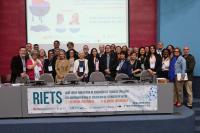The Global Health Workforce Crisis: What we can learn from the Ebola outbreak?
When the Ebola crisis eventually begins to diminish, and the journalists and camera crews withdraw, public interest fades and political pressure on leaders subsides, the people of Sierra Leone, Liberia and Guinea will be left to rebuild their lives, their communities and their countries. Understanding the problems that led to the escalation of the Ebola crisis is essential in order for these countries to emerge safely from it and to prevent another crisis in the future.
The ability of a country to contain an outbreak of an infectious disease like Ebola is largely dependent on the strength of its healthcare system and on having enough staff working within it to cope with the crisis. Clearly the healthcare systems in the affected countries were too weak to control the outbreak. For example, Sierra Leone had 119 doctors serving a population of nearly six million people. This meant that for every 50,000 people in Sierra Leone, there was one doctor compared to a 100 in the UK. That ratio in Sierra Leone falls well below the WHO’s recommended minimum of at least 23 doctors, nurses and midwives per 10,000 of the population.
In Liberia and Guinea, the shortage of healthcare workers is even worse. In these countries, there is only one doctor for every 100,000 people. In addition to the severe shortage of health workers, there are also problems in terms of the number of health facilities accessible to citizens and insufficient medical supplies. For example, in Liberia, there are only 3,352 hospital beds for a population of nearly 4.5 million. Guinea has a similar number of beds (3,435) for a population of nearly 11.5 million. It is hardly surprising then that these countries have struggled to contain the Ebola virus.
Inequality and the rich country drain on health workers
The health worker shortage in Africa is a stark example of global inequality. According to WHO research, Africa has the highest burden of disease of any continent, but has only 3% of the world’s health workers, and less than 1% of the world’s financial resources. While the continent continues to grapple with infectious diseases, such as HIV, malaria, cholera, tuberculosis and child pneumonia, as well as problems with maternal health, there has also been a rise in noncommunicable diseases. But the number of health workers to respond to these challenges remains remarkably few.
In order to address the unequal distribution of healthcare workers, we need to understand the labour market dynamics that affect the training, recruitment, deployment and performance of global and local health workforces. There is a global shortage of healthcare workers, affecting high-, middle-, and low-income countries, from the USA and Germany to India and Uganda. The difference between high-income countries and low- and middle-income countries lies in their ability to address these health workforce shortages, and to invest in the recruitment and training of medical staff and managers. Too often, richer countries simply recruit staff from poorer ones. It is estimated that10% of Sierra Leone’s trained nurses are working in the UK health system.
There are many issues that lead health workers to seek employment outside their country of origin, including low salaries, inadequate health facilities and a lack of training and career development. Serious investment in these areas is needed in order to avoid the damage to local health services that is caused through the loss of healthcare workers. When significant numbers of doctors and nurses leave the countries that financed their education, there is a huge loss of public investment which makes it more difficult to deliver services and to offer education and training to people who wish to enter the health profession in the future. While workers should enjoy freedom of movement, mechanisms should be in place to support their retention, such as improving working conditions, and remuneration and career development. In Zambia, for example, healthcare workers receive an extra 25% recruitment and retention allowance on top of their basic salary, which has been effective in decreasing the migration of nurses.
Ensuring countries have the human resources tackle health crises
Wealthier nations are more able to make these kinds of investments, not only within their own borders, but internationally through providing aid and sharing expertise. A recent Global Forum on Human Resources for Health recommended that each country with severe healthcare personnel shortages should be supported to develop and implement a budgeted plan to strengthen its health workforce, as part of a broader national health strategy. This should include a special focus on the most poor and marginalised sections of society, as well as strategies to train skilled health workers and maximise their performance.
The Ebola crisis has undermined the economic progress that Sierra Leone, Liberia and Guinea were making, thereby limiting the ability of these governments to make much-needed investments in their public services. It has, however, also succeeded in focusing attention on the shockingly unequal distribution of healthcare workers, which stands in the way of achieving key public health priorities, such as reducing child mortality, improving maternal health, increasing vaccine coverage, and combating HIV/AIDS, malaria and other diseases.
The international community must invest in human resources for health for all. Health workers are the basis of a functioning healthcare system, which in turn helps to drive economic growth, save lives and improve the quality of life for millions of people around the world.
Available on: http://www.globalhealthcheck.org/?p=1722



